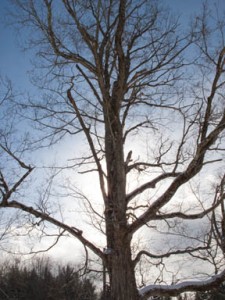
Planting for Knowledge School Seedling Program
Planting and caring for a seedling tree can help young people learn about the natural world and the value of trees in it. DEC’s school seedling program provides New York State’s school students with this experience.
Why Participate?
Most of us recognize the beauty of trees and their many other values. Trees provide food and shelter for wildlife and prevent loss of soil (erosion).
They help protect our streams and lakes by stabilizing soil and using nutrients that would otherwise wash into waterways. Trees help moderate temperature and muffle noise. They even help improve air quality by absorbing some airborne compounds that could be harmful to us, and by breathing out oxygen.
When students plant tree seedlings, they can see for themselves the structure of trees, learn what they need and how they grow. Teachers can use the planting process to discuss the benefits trees provide, while including many subjects that their classes are studying. As seedlings mature, the young trees can be a continuing, personalized way of relating book learning to visible, living examples of what is being taught.
Personal involvement in establishing a grove of trees will help students become aware of their role in protecting the environment. Ultimately, the experience will also help them make intelligent decisions about conservation and use of natural resources.
Who is Eligible?
All schools may participate – public, private or parochial; nursery, elementary, secondary, vocational, college or university. Any school-sponsored organization is also eligible. Planting can be related to a wide variety of scholastic programs – it is not confined to any given subject, purpose or age level.
The department encourages planting on school property so that students can be responsible for the care and protection of the seedlings. Other possible locations are parks, roadsides, public buildings and nursing homes.
What’s Available?
DEC’s Saratoga Tree Nursery will have species of both spruce and pine available for participants in this program, School Seedling Brochure, (pdf, 88kb). Only one of the offered species may be ordered and 50 seedlings of that species will be given to each participating school. You will need 1,800 square feet of open space for 50 seedlings. Each needs a growing space about six feet in diameter.
For schools where planting space is limited, an urban wildlife packet is available. This contains 30 seedlings of shrubs that are particularly attractive to songbirds and, planted six feet apart, require only 900 square feet of open space.
Getting Started:
Get in touch with your Regional Forestry Office for specific information about this program in your area. A forester will be available to advise you on the appropriate species of trees to choose and proper planting technique.
Species available:
White Pine (Pinus strobus): Native long-needled evergreen. Grows best in well-drained soils and reaches heights in excess of 100 feet. Can be planted statewide. Avg. hgt 8″-12″
Norway Spruce (Picea abies): European short-needled evergreen. Will grow in clay and loamy soils and reaches heights in excess of 100 feet. Can be planted in most parts of New York except northern areas. Avg. hgt 12″
White Spruce (Picea glauca): Native short-needled evergreen. Grows in clay and loamy soils and reaches 70 feet at maturity. Can be planted statewide. Avg. hgt 12″
Packet #2: Urban wildlife packet contains a mix of 30 wildlife shrub seedlings. Will grow in clay and loamy soils. Plant varieties of the same kind together to promote pollination and fruiting. Can be planted statewide.
The seedlings you receive will be two or three years old and approximately 8 to 16 inches tall. Shipment will be by UPS, beginning in early April through the second week in May. Select a shipping date at least three days prior to the planting date. Shipping is on Monday, Tuesday or Wednesday to avoid weekend warehouse storage.
Planting Instructions
Seedlings are perishable. Follow handling instructions printed on bags to ensure survival.
TOOLS REQUIRED: Shovel and bucket
1. Place the seedlings in a bucket and fill with water until all the roots are covered.
2. Remove all vegetation down to the soil layer for at least one foot around the planting site.
3. Dig a hole large enough to contain the roots.
4. Place the roots of the seedling in the hole and carefully spread them out. The root collar (where roots join the stem) should be at or just below the ground’s surface. The seedling should stand straight.
5. Fill the hole with soil and gently compact the soil to remove air pockets that could dry out the roots.
6. Water the seedling slowly and thoroughly after planting to settle the soil. If rainfall is not adequate, water weekly after planting for the first year.
7. Mark the seedlings with a stake so they won’t be cut off with a lawn mower.
8. Fertilizer is not recommended at planting time. It can be applied two or three years after planting when the root system has developed.
NYS DEC
Saratoga Tree Nursery
2369 Route 50 South
Saratoga Springs, NY 12866-4738
Telephone: (518) 581-1439
